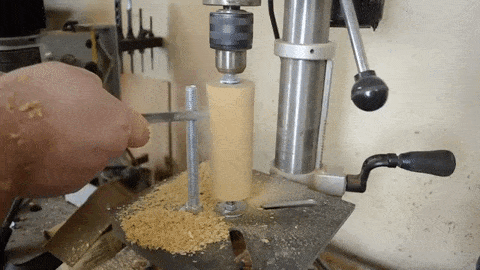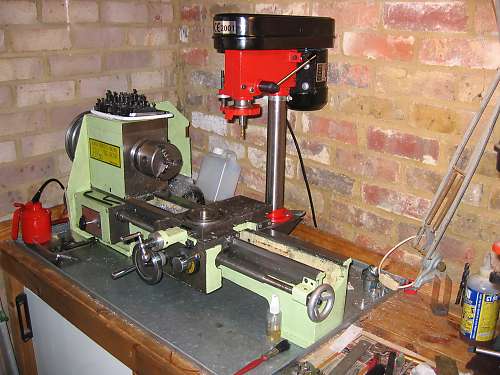Yes, a drill press can be used as a lathe, but with limitations. It is not designed for lathe functions and may lack precision.
Many DIY enthusiasts and hobbyists ponder if they can maximize their tools’ functionality. The idea of using a drill press as a lathe is intriguing. It can save space and money. However, safety and efficiency are crucial. While the concept is possible, understanding the limitations and risks is essential.
In this blog post, we will explore how to convert a drill press for lathe use. We will also discuss the potential benefits and drawbacks. This will help you make an informed decision. Let’s dive into the details and see if this tool transformation suits your needs.

Credit: www.popularmechanics.com
Article Summary
Introduction To Drill Press And Lathe
Drill presses and lathes are essential tools in any workshop. They serve different purposes but share some similarities. Understanding their basic functions and key differences can help you determine if a drill press can be used as a lathe.
Basic Functions
A drill press is designed to drill holes in various materials. It provides precision and consistency in drilling tasks. The drill press holds the workpiece steady while the drill bit moves vertically.
A lathe, on the other hand, is used for shaping materials. It rotates the workpiece against a cutting tool. This allows you to create cylindrical shapes, threads, and other precise forms.
Key Differences
The main difference lies in the motion. In a drill press, the drill bit moves. In a lathe, the workpiece rotates. This fundamental difference affects their specific applications and capabilities.
Another difference is in their design. Drill presses are built for vertical movement. Lathes are built for rotational movement. This makes each tool suitable for its intended tasks.
Understanding these differences helps in deciding if a drill press can substitute for a lathe. While they share some features, their core functions are distinct.
Using A Drill Press As A Lathe
Have you ever wondered if your drill press could do more? Many DIY enthusiasts ask if a drill press can be used as a lathe. The short answer is yes, but it requires some adjustments. Let’s dive into the details.
Feasibility
Using a drill press as a lathe is possible. But it comes with limitations. A drill press is not designed for lateral forces. This is a key point to consider. Lathes are built to handle sideways pressure. Drill presses are not.
For small projects, a drill press can work. It can handle tasks like shaping wood or soft materials. But it is not suitable for heavy-duty tasks. Understanding these limits is crucial for safety and success.
Necessary Modifications
Converting a drill press into a lathe requires some modifications. Below is a table outlining the key changes needed:
| Modification | Description |
|---|---|
| Tool Rest | Add a tool rest to support your chisels. |
| Work Holding | Use a chuck or faceplate to hold the workpiece. |
| Speed Control | Adjust the speed to match the material you’re working with. |
Follow these steps to modify your drill press:
- Install a tool rest near the chuck.
- Secure the workpiece using a chuck or faceplate.
- Adjust the speed settings for your material.
These modifications make your drill press more versatile. But always keep safety in mind. Wear protective gear and work slowly. Your drill press can become a useful lathe for small projects.
Pros Of Using A Drill Press As A Lathe
Many woodworkers and hobbyists find using a drill press as a lathe useful. It can be a smart choice for various reasons. Below, we explore the benefits of this approach.
Cost-effectiveness
Buying a separate lathe can be expensive. A drill press, on the other hand, is often cheaper. For those on a budget, this is a huge advantage. You get to save money while still achieving good results.
With some simple modifications, a drill press can handle basic lathe tasks. This means you don’t need to buy extra machines. This can lead to significant savings.
Space-saving
Many people have limited workspace. Owning multiple machines can take up too much room. Using a drill press as a lathe helps save space. You can perform two functions with one machine.
This is ideal for small workshops or garages. You maintain a tidy workspace. And you can still accomplish your projects without cluttering your area.
Cons Of Using A Drill Press As A Lathe
Using a drill press as a lathe might seem like a good idea. It can save money and space. But there are downsides to this approach. Understanding the cons can help you make a better decision. Let’s explore some of the key issues.
Safety Concerns
Safety is a major concern when using a drill press as a lathe. Drill presses are not designed for side loads. This can lead to instability. The workpiece might shift unexpectedly. This can cause serious injuries. The chuck might not hold the workpiece securely. This increases the risk of accidents.
A drill press lacks proper guards. These guards are essential in preventing injuries. Without them, flying debris can cause harm. Always wear safety gear. But even with gear, the risk remains high.
Performance Limitations
A drill press cannot match a lathe’s performance. Drill presses lack the precision of lathes. This affects the quality of the work. The motor of a drill press is not designed for continuous side pressure. This can lead to overheating and damage.
Speed control is limited in drill presses. Lathes offer variable speeds for different materials. Drill presses do not. This limits the types of projects you can do. The finish of the workpiece may also suffer. This reduces the overall quality.
Safety Measures
Using a drill press as a lathe can be dangerous. Therefore, it is essential to follow safety measures. This ensures you stay safe while working. Here, we will discuss proper equipment and precautionary steps to help you work safely.
Proper Equipment
Having the right tools is crucial for safety. Here are some essential items:
- Safety Goggles: Protects eyes from flying debris.
- Face Shield: Offers additional protection for the face.
- Gloves: Keep your hands safe from sharp objects.
- Dust Mask: Prevents inhalation of harmful particles.
- Clamps: Secure the material firmly.
Precautionary Steps
Following precautionary steps reduces the risk of accidents. Here are some important steps:
- Inspect Tools: Check the drill press and other tools before use.
- Secure Work Area: Ensure the work area is clean and free of clutter.
- Use Clamps: Always secure the material with clamps. This prevents it from moving.
- Wear Safety Gear: Always wear goggles, gloves, and a dust mask.
- Stay Focused: Pay attention and avoid distractions while working.
- Emergency Plan: Have an emergency plan. Know what to do if something goes wrong.
Performance Expectations
Using a drill press as a lathe can be a practical solution for DIY enthusiasts. But what are the performance expectations? This section will dive into the key aspects to consider, such as material compatibility and the quality of work.
Material Compatibility
One important factor is the type of materials you can work with. A drill press is not as versatile as a dedicated lathe. It’s best suited for softer materials like wood and some plastics. Harder materials like metals may pose challenges.
Below is a table summarizing the compatibility:
| Material | Compatibility |
|---|---|
| Wood | High |
| Plastic | Moderate |
| Soft Metals | Low |
| Hard Metals | Very Low |
Quality Of Work
The quality of work you can achieve with a drill press acting as a lathe may not meet professional standards. It is adequate for simple DIY projects. Precision and finish could be compromised.
Consider the following points:
- Surface Finish: May be rough.
- Accuracy: Less precise than a true lathe.
- Tool Holding: Less stable.
If your project demands high precision, a dedicated lathe is a better choice. But for basic tasks, a drill press can suffice.
Expert Opinions
Experts debate whether a drill press can replace a lathe. While possible for light tasks, it’s not ideal. Consider tool limitations and safety.
Understanding the potential of using a drill press as a lathe requires insights from experts. Professionals in woodworking and metalworking have shared their thoughts. They highlight both the possibilities and limitations.Professional Insights
Many experts agree that a drill press can be adapted for lathe-like tasks. For small projects, it works well. Professionals note that the drill press lacks some features of a true lathe. For instance, it has limited speed control. This can affect the quality of the work. Additionally, a drill press isn’t designed to handle the same level of lateral force. This can lead to quicker wear and tear. Safety is also a concern. Experts emphasize the importance of proper setup and caution.User Experiences
Users have mixed experiences with using a drill press as a lathe. Some find it useful for light tasks. They appreciate its versatility for simple turning jobs. Especially for beginners, this can be an affordable alternative. Others find it inadequate for more detailed work. They mention issues with precision and stability. Some users report frequent adjustments and modifications. This can be time-consuming and frustrating. Overall, user experiences vary based on the complexity of the task. For basic projects, a drill press may suffice. For intricate or heavy-duty work, a proper lathe is recommended. “`
Credit: hackaday.com

Credit: makezine.com
Frequently Asked Questions
Can A Drill Press Function As A Lathe?
Yes, a drill press can be used as a lathe for light-duty tasks. It’s not ideal for precision work, but it can handle simple turning tasks with the right attachments.
What Are The Limitations Of Using A Drill Press As A Lathe?
A drill press lacks the rigidity and precision of a lathe. It’s suitable for small, non-critical tasks. Heavy-duty or precise turning isn’t recommended.
How To Convert A Drill Press To A Lathe?
To convert a drill press to a lathe, you need a suitable attachment. Secure the workpiece on the drill press table and use a cutting tool.
Is It Safe To Use A Drill Press As A Lathe?
Using a drill press as a lathe can be unsafe if not done carefully. Ensure all attachments are secure and follow safety guidelines.
Conclusion
Using a drill press as a lathe is possible with some limitations. It offers a budget-friendly option for light woodturning projects. Always prioritize safety and understand the tool’s constraints. Proper setup and technique are crucial for success. Experiment with small projects first.
Learn and practice to gain confidence. A dedicated lathe remains the best choice for serious woodturning. Consider your needs and skill level before deciding. Happy crafting!